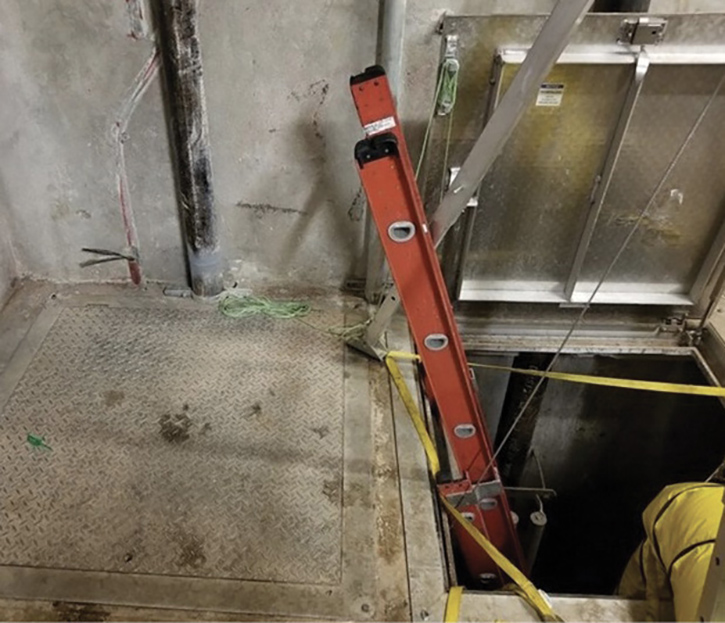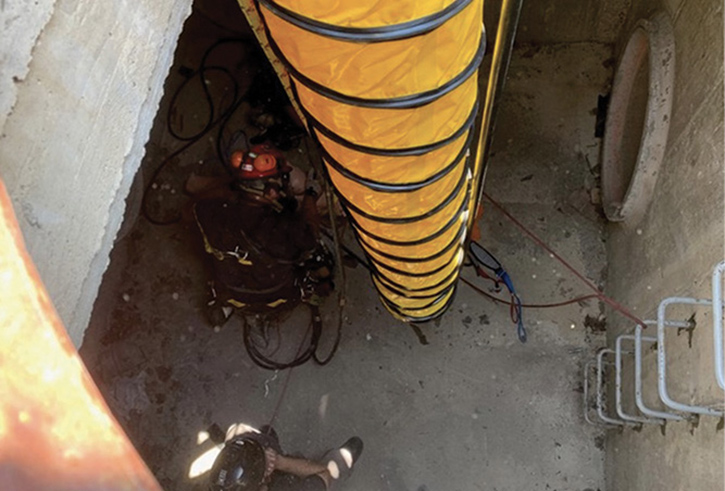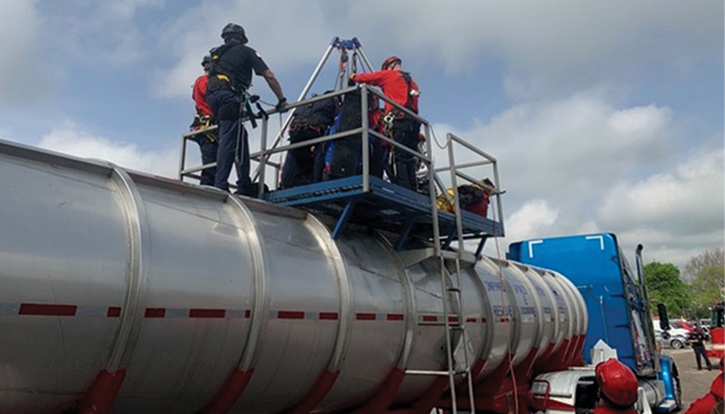
According to the Occupational Safety and Health Administration, more than two million American workers enter confined spaces annually, and approximately 92 fatalities result from confined space entries. Countless other emergencies may go unreported since these events might not have resulted in a worker’s death. Based on these statistics, it is likely that a firefighter will respond to a confined space emergency at some point in his career.
As a firefighter, you are tasked with responding to a wide variety of incidents, some for which you may not be trained. With confined space rescue emergencies, many of us may not have had the luxury of working with personnel trained in confined space rescue and technical rescue teams; depending on your area, these teams could take an hour or more to arrive. This poses the question: As the first-in company, what can you do at a confined space rescue emergency in the minutes leading up to the technical rescue team’s arrival?

(1) Crews perform on-site standby rescue during an inspection on a major roadway in Chicago, Illinois, in 2019. (Photos by author.)

(2) Inspectors access an underground storage pit for an annual inspection in Houston, Texas, in 2019.

(3) Members of MABAS Division 1 Technical Rescue Team perform ventilation of a confined space during an NFPA 1670 Confined Space Technician course delivered by Elevated Safety at the Northeastern Illinois Public Safety Training Academy in June 2020.
RELATED FIREFIGHTER TRAINING
How to Expedite a Confined Space Rescue
Confined Space Rescue: Body Recovery vs. ‘Buddy’ Recovery
Preparing for the Rescue
First, while you wait for “the cavalry,” make sure the appropriate resources have been dispatched. Depending on your response area, this resource may be a full-time rescue company staffed for your community or a countywide response that summons vehicles and personnel from multiple or mutual-aid departments. It will take time for those resources to arrive, so it is critical to alert the department as soon as possible. If the call is unfounded or the victim has been rescued prior to the department’s arrival, you can turn away the technical response team.
Next, inform the dispatch center of the requirements for your call. Many dispatch centers will send technical rescue personnel and equipment on notification of a confined space emergency.

(4) Members of MABAS Division 1 Technical Rescue Team perform a rescue of a victim in a confined space during the NFPA 1670 Confined Space Technician course.
However, you may also require hazardous materials personnel if chemicals or other contamination hazards are present. These personnel can provide resources that technical rescuers may not possess such as expertise in air monitoring, decontamination, and other procedures. In addition, they have access to advanced personal protective equipment (PPE) and other resources. Once you have notified the correct resources, answer a few baseline questions, which follow. Answers may come from your dispatch center while your team is en route to the scene or from on-site personnel when you arrive.
- What work was being performed in the space?
- How many workers were inside?
- What is the condition of the patient?
- When was the last communication with the patient?
- What PPE was the patient wearing—i.e., was the patient in a harness and attached to a lifeline?
- What were the known hazards of the space?
- Who performed lockout/tagout of the space? And is there a maintenance person or someone else familiar with the space you can call?
- Where is the entry permit and air-monitoring log?
Tactics
On arrival, the officer should establish the incident command system, switch to a tactical radio frequency, and begin obtaining answers. As the same time, crew members can start establishing contact with the victim by voice, radio, or some other method, depending on the location of the victim. If the confined space is accessible vertically, have a member check for an on-site retrieval system that consists of a winch or mechanical advantage system. If you can see the victim and a retrieval system is on site and attached, crews can use this system to rescue the victim without entering; if not, an entry rescue will be required, unless a stick clip or other device is available to attach a retrieval system to the victim without entering the space.
Next, have a member take air quality readings with a four- or five-gas monitor. If readings fall within normal ranges, you can rescue the victim with a nonimmediately dangerous to life or health entry. If air quality readings are outside normal ranges, begin quick and correct ventilation. Accomplish this ventilation by whatever electric- or battery-powered fans are at your disposal. If you do not have a confined space-specific fan on your rig, use an intrinsically safe electric positive pressure ventilation fan or smoke ejector, if available. Refrain from using gas-powered equipment and fans, which will almost certainly contaminate the already dangerous emergency scene.
Next, have another member meet with an on-site maintenance person or operations manager who is familiar with the site and processes of the facility and verify its lockout/tagout. This is critical; many industrial facilities have extraordinarily complex lockout procedures for their equipment. Only those who work on these machines every day possess the knowledge to safely isolate and eliminate sources of stored energy so members can safely enter and access the space. These facility experts will also be vital in identifying atmospheric hazards or unique chemicals that a four- or five-gas monitor may not pick up. If you cannot contact this expert or if he is not within view and no tagline is attached, assume that an entry rescue by operations or technician level personnel will be required.
At this point, establish zones of operation—hot, warm, and cold. Many departments consider the hot zone within 100 feet of the emergency, the warm zone 100 to 200 feet from the emergency, and the cold zone beyond 200 feet of the scene. These distance parameters may not make sense when working in an industrial plant or facility. It is necessary to designate the zones with fire tape, cones, or other means to make sure no unauthorized personnel are in the work area of the incident.
After you obtain baseline information, complete air monitoring, verify lockout/tagout, and establish safety zones, require rescuers to make entry and rescue or recover the victim. This is the time to turn the scene over to your technical experts, who make up your area’s confined space rescue team. With this knowledge and information, you and your crew are prepared for the next confined space emergency and ready to manage the initial phase of the incident.
ROSS CHAPMAN is a 13-year fire service veteran and a lieutenant with the Arlington Heights (IL) Fire Department, assigned to Tower 1. He is a member of the MABAS Division 1 Technical Rescue Team. Chapman is also a rescue squad officer with Illinois Urban Search and Rescue Task Force 1 and is a certified urban search and rescue specialist through the Texas A&M Engineering Extension Service. He is co-managing director of Elevated Safety, which specializes in rope rescue, rope access, and confined space projects and training. Chapman has written articles for Fire Engineering and Facilities Safety Management. He has a bachelor’s degree in fire service management from Southern Illinois University and a master’s degree in emergency services management from Columbia Southern University.

